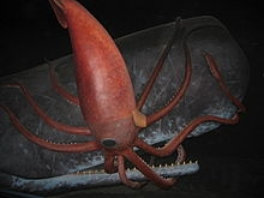
Contact

Home
International Sea Serpent Reports
MONSTER OF DEEP
Sea Serpent Seen From Liner
SNOUT WITH SPIKE
The Daily News (Perth, WA)
Date: May 24, 1933
Page Number: 1
LONDON, May 23.
Travellers by the liner Largs Bay, which reached Southampton from Australia today, report having seen a monster sea-serpent when, the liner was off Aden.
The sea-serpent leapt purtly out of the water about a cable's length (600 feet) from the ship.
Eye-witnesses stated that they saw about 20ft. of the monnfer, which appeared to be like an elongated fish, rear itself twice from the sea.
The sea-serpent had a bulging head with a circumference greater than that of the body, and there was a long spike or tongue projecting from the snout.
Aden, Yemen


SS Largs Bay
These Sea Serpents
Cuttlefish Says Mr Glauert
The Daily News (Perth, WA)
Date: May 25, 1933
Page Number: 6
SEA SERPENTS! A monster of the deep raised a great writhing body to about 20 feet in the air, with a bulging head and a long spike thereon. Passengers in the Largs Bay reported having seen it when the vessel returned yesterday to Southampton.
Their story is not doubted, but the explanation is not sea serpents, but cuttlefish.
The Curator of the Museum (Mr. L. Glauert) advanced this theory, too, which is always given by authorities in England and America. There were in the ocean, he said, great cuttlefish with arms from 20 to 30 feet in length, giants of the species of the squids seen around our coast. Their arms tapered for a little way, and then continued like a serpent's body, terminating in a swelling, which was finished with a spike.
"I suggest," said Mr. Glauert, "that what the people on the Largs Bay saw was one of these giant cuttlefish, floating just below the surface of the water, and rearing one of its suckers above. These cuttlefish are quite common. One of them was recently washed up on the coast at Scarborough, in England, with arms 30 feet long. "There are lots of very strange cases of sea serpents, which are explained as cuttlefish, but they are usually seen from a considerable distance in the ocean.
REAL SEA SNAKES
"MILLIONS of years ago there were real reptiles in the ocean, like the true snakes. These were 10 to 30 feet in length.
"There are still real sea snakes, 10 feet or more in length, in the seas around the north coast of Australia.
"People travelling up the north coast have seen them lying on top of the water — sleeping. There are fresh water snakes, up north, too. They are usually land snakes which have taken to the water, because they find it easier to get a living. Land varieties down here are usually good swimmers, too. Some of the kinds of sea snake are more greatly specialised. The scales on the upper part of the body have become smaller, as on the lower side, and the tale develops like a paddle to assist the snake in swimming.
ALL POISONOUS
"THESE fish are all poisonous. There is one kind, popularly called the black and yellow sea snake, which is most highly specialised. This variety is most widely distributed. They swim across the Pacific to Western America, are found on the West Coast of Africa, and are common on our beaches in the winter. During the North-West storms they are washed up on our beaches, and are usually about 30 inches long. I have seen many of them, and have poked at them with a stick. I would not care to pick them up, for even though they are numbed with the cold, they are still half-alive. They are practically powerless, and if one pushes them back into the water they are just washed up again by the waves on to the beach.
"They have been found at Albany, and even as far south as Tasmania. Europeans have been bitten by them in India, and have died as a result.
"There have been stories of giant cuttlefish seizing small boats. They could easily do so with their long arms, and capsize the boat. They inhabit the deep parts of the ocean and are the staple diet of the sperm whale. The battles between the preyer and the cuttlefish are terrific."


Ludwig Glauert
(1879-1963)
Cultural Heritage: English
Occupation: conservationist, herpetologist, museum administrator/curator/director, natural history collector, palaeontologist, public servant, zoologist


Giant Squid
Sperm Whale


The Sydney Mail (NSW)
Date: May 31, 1933
Page Number: 30
The sea-serpent sighted by the Largs Bay liner at Aden brings up the question of the real nature of such apparitions in Australian waters, particularly also the south coast of New South Wales. Here the sceptics favour the view that what usually appears to be a sea-serpent is actually a death tussle between a sperm whale and a giant sea squid. Sometimes the marauding whale bites off more than it can chew, and a battle royal is staged at the surface. What wonder f[???] men and landlubbers think the heaving bulk, reptile writhings, and tentacles whipped erect out of the water are the traditional sea-serpent. Even the whistling sometimes heard may be the gasping whale sneezing through a blow-hole clogged with mangled squid, while the reported “jets of smoke” may be puffs of inky water from the squid’s syphon.











